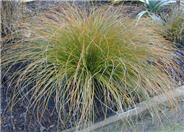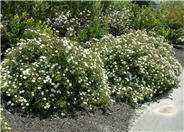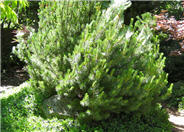
Common name:Orange Sedge
Botanical name:Carex testacea
The testacea variety is an evergreen perennial that reaches 2' tall bearing very narrow, coppery brown leaves splitting to hair-like threads at their tips, and continuing to grow to 4-8' in length. This plant should be grown in sun with little or no summer watering. During winter, foliage turns orange. If this grass is planted in shade, foliage stays green. Flowers are insignificant. Orange Sedge looks great in containers or spilling over near walkways or into water features.

Common name:White Rockrose
Botanical name:Cistus X hybridus
This is a small evergreen shrub with 2" long gray green, crinkly leaves. It has pure white flowers with prominent yellow stamens. It flowers throughout the spring to early summer. Avoid heavy mulches.
.

Common name:Purple Smoke Tree
Botanical name:Cotinus coggygria 'Purpureus'
A deciduous shrub or small tree that grows up to 10' tall, the "Purpureus" is grown for its wispy, thread-like flower clusters in summer. Its green foliage turns a brilliant purple and then yellow to red in the fall. This shrub is a show stopper! It prefers full sun but will do better with afternoon shade in hot inland areas. This attractive shrub is drought tolerant once it's established.

Common name:Mugho Pine
Botanical name:Pinus mugo
Pinus mugo is an evergreen tree or shrub that grows slowly, from 5' -20' tall. Needles are 2", dark green, stout, and crowded. Cones are 1"-2", oval, and tawny to dark brown. Generally a bushy, twisted, somewhat open pine, mostly grown as a shrub or bonsai plant.

Common name:Blue Oak
Botanical name:Quercus douglasii
Blue Oak is a deciduous tree that has a slow growth rate and reaches 50 ft. high. It develops 2" long, lobed blue-green leaves. Blue Oak is very drought tolerant, is native to California and attracts butterflies. Because of its slow growth, it can be used for bonsai. Flowers are insignificant. Acorns were used by California Natives for food.
Designer: Laurie Sager & Associates
Photographer: GardenSoft
Incorporate compost 6" into your soil to retain water, reduce compaction, feed earthworms, and provide valuable nutrients to your plants.
Attract, or buy beneficial insects such as ladybugs and lacewings to control pest outbreaks in your garden.